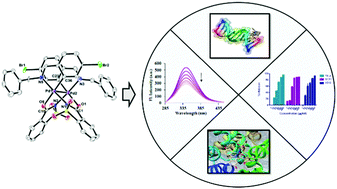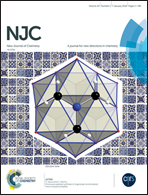A saccharinate-bridged palladacyclic dimer with a Pd–Pd bond: experimental and molecular docking studies of the interaction with DNA and BSA and in vitro cytotoxicity against human cancer cell lines†
Abstract
A new palladacyclic dimer [Pd2((C,N)L)2(μ-Sac)2] (1), in which L: C14H11NBr and sac: the saccharinate ligand, has been synthesized and completely characterized. X-ray crystallography has been used to determine the single crystal structure of this Pd(II) complex. In this dimer, two palladium(II) centers are bridged by a saccharinate anion, which is coordinated to the cyclopalladated units as a bidentate (N- and carbonyl O-atoms) ligand. According to DNA binding studies (UV-Vis spectroscopy, emission titration and viscosity measurements), the Pd(II) complex interacts with calf-thymus DNA (CT-DNA) through a groove binding mode with a binding affinity on the order of 105. Furthermore, UV-Vis and fluorescence emission spectroscopy have been used to monitor the binding of the complex to bovine serum albumin (BSA). The complex is mainly located in site I of the protein, based on the competitive experiments using Warfarin, Ibuprofen and Digoxin as site markers. The results of molecular docking confirmed the experimental data. Finally, the in vitro cytotoxicity of sodium saccharin, ligand LH (C14H12NBr), complex 1 and cisplatin against cervical cancer (HeLa), lung cancer (A549) and breast cancer (MCF-7) cell lines has been studied. The complexation process has significantly improved the anticancer activity, as the IC50 values show. Furthermore, complex 1 has been tested against NIH normal fibroblast cells. Therefore, based on the SI definition, 1 can be assigned as a selective compound against cancer cells.



 Please wait while we load your content...
Please wait while we load your content...